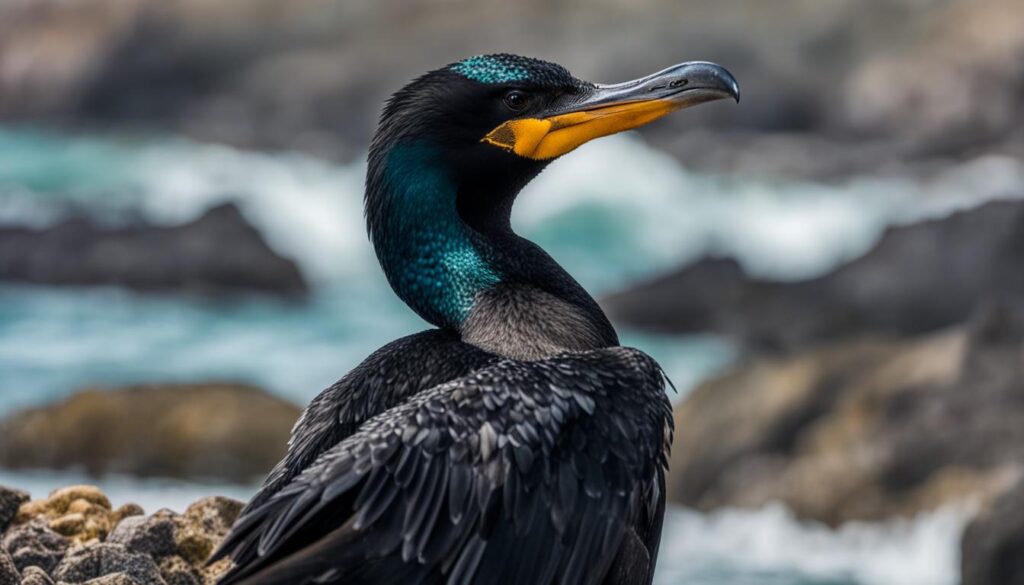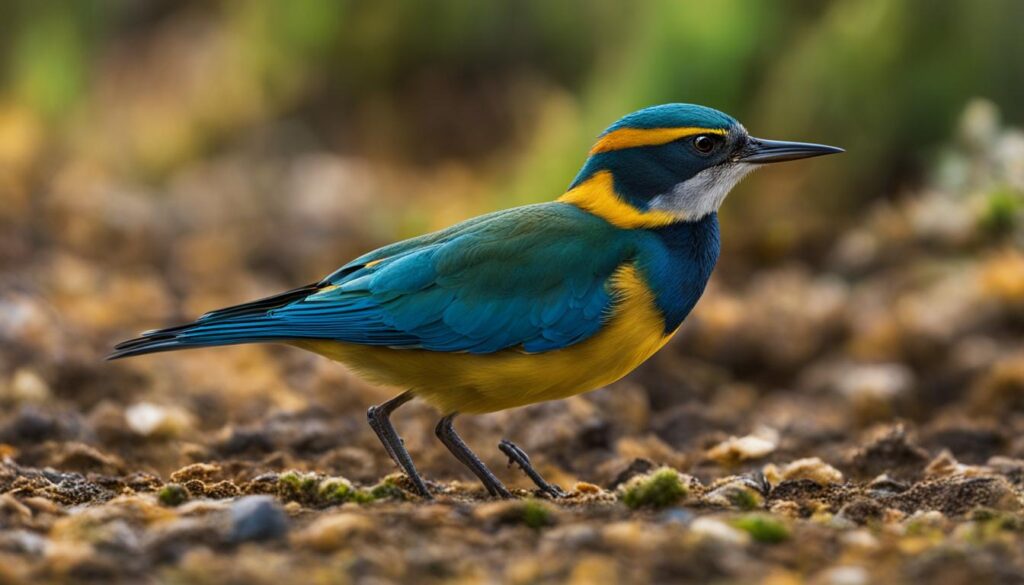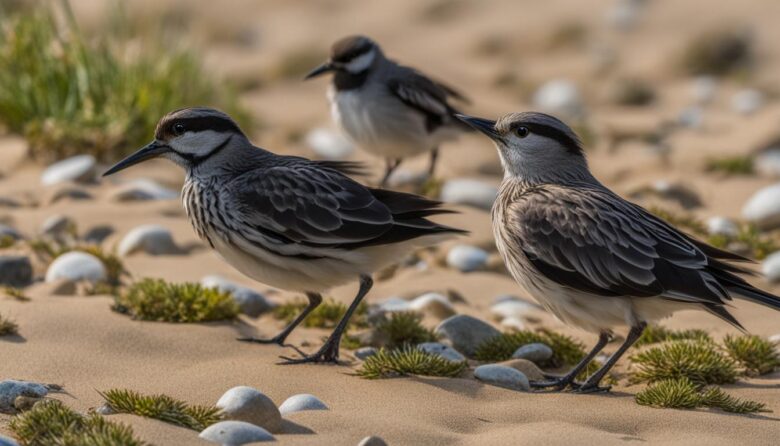You will discover Non Flying Birds Name. Did you know that there are bird species that cannot fly? These flightless birds, also known as non-flying birds, have unique characteristics that set them apart from their airborne relatives. In this article, we will explore the fascinating world of flightless bird species and discover their names and intriguing features.
From the Galapagos Islands comes a remarkable bird called the flightless cormorant. Unlike its flying relatives, this bird is unable to take to the skies. It boasts a larger size and stumpy wings, making its flightlessness apparent. The cormorant’s unique bone structure, affected by skeletal disorders known as ciliopathies, contributes to its inability to fly.
Despite its flightlessness, the flightless cormorant remains active and playful. You can spot it running and jumping around Fernandina Island, displaying its remarkable agility. When it comes to meals, this earthbound avian wonder has a taste for rockfishes, octopi, and eels. Unlike many birds, it is not afraid of humans, allowing observers to get up close and appreciate its unique beauty in the Galapagos Islands.
Stay tuned as we delve deeper into the fascinating adaptations of the flightless cormorant and explore their interaction with humans. We will also discuss recent developments in bird taxonomy and the renaming of bird species, shedding light on the evolving perspectives on species naming and classification.
Unique Adaptations of the Flightless Cormorant
The flightless cormorant from the Galapagos Islands boasts a range of unique adaptations that allow it to thrive despite its inability to fly. These adaptations have enabled the cormorant to carve out a niche in its environment and become a fascinating example of evolution in action.
Firstly, the flightless cormorant has developed a larger body size compared to its flying relatives. This increase in size is a result of natural selection, as larger individuals have a greater advantage when foraging in the sea. With its strong swimming abilities, the cormorant can dive into the water to catch prey such as rockfishes, octopi, and eels.
Another intriguing adaptation of the flightless cormorant is its unusual sunbathing behavior. Unlike other cormorant species, which have oily wings to aid in flight, the flightless cormorant lacks this natural waterproofing. As a result, it spends a significant amount of time sunbathing to dry its wings. This behavior showcases the cormorant’s ability to adapt to its unique circumstances and find alternative ways to maintain its body condition.
The flightless cormorant’s distinctive skeletal structure, including its protuberant chest and stumpy wings, is the result of skeletal disorders known as ciliopathies. These disorders affect the bird’s bone development, causing its wings to be underdeveloped. Despite these physical limitations, the flightless cormorant is a skilled hunter that can eat once or twice a day, further highlighting its ability to overcome challenges and thrive in its environment.
| Unique Adaptations of Flightless Cormorant | Features |
|---|---|
| 1 | Larger body size |
| 2 | Strong swimming abilities |
| 3 | Sunbathing behavior |
| 4 | Skeletal disorders (ciliopathies) |
The flightless cormorant exemplifies the incredible adaptability of bird species, even in the absence of flight. Through their unique adaptations, these birds have found new ways to survive and thrive in their environment. Their larger body size, strong swimming abilities, sunbathing behavior, and skeletal disorders allow them to navigate the challenges they face, reminding us of the remarkable diversity of life on Earth.
The Galapagos Cormorant’s Interaction with Humans

The flightless cormorant from the Galapagos Islands is a fascinating bird species that has captured the interest of both locals and tourists. It is known for its unique interaction with humans, as it is not afraid to approach them closely. This fearlessness and curiosity make the flightless cormorant an ideal subject for observation and appreciation. However, it is crucial to prioritize the well-being of these earthbound avian wonders and avoid causing any disturbances to their natural behavior.
When visiting the Galapagos Islands, it is important to respect the flightless cormorant’s environment and adhere to guidelines set by the local authorities. This includes maintaining a safe distance, refraining from touching or feeding the birds, and refraining from making loud noises or sudden movements that may startle them. By observing these guidelines, visitors can have the opportunity to witness the flightless cormorant in its natural habitat, engaging in its daily activities.
The flightless cormorant’s fearlessness towards humans stems from the absence of natural predators in its environment. Over time, it has become accustomed to the presence of humans and has learned that they pose no harm. This unique interaction serves as a reminder of the delicate balance between nature and human presence. As visitors, we have the responsibility to ensure that our actions do not disrupt the flightless cormorant’s behavior or compromise its well-being.
Table: Guidelines for Interacting with Flightless Cormorants in the Galapagos Islands
| Do’s | Don’ts |
|---|---|
| Observe the flightless cormorants from a safe distance | Approach or touch the flightless cormorants |
| Respect their natural behavior and habitat | Feed the flightless cormorants |
| Keep noise levels low | Make sudden movements that may startle the flightless cormorants |
| Follow the guidelines set by local authorities | Disrupt the flightless cormorants’ environment |
Visiting the Galapagos Islands offers a unique opportunity to witness the remarkable flightless cormorants up close. By respecting their natural behavior and habitat, we can contribute to their preservation and ensure that future generations can continue to appreciate these magnificent birds in their pristine environment.
Bird Name Changes in North America
In recent news, the American Ornithological Society announced that the common names for approximately 150 North American bird species will be changing in the near future. This renaming of birds is generating a lot of interest among birders. Similar changes in bird names may also occur outside of North America. The renaming aims to provide more accurate and scientifically meaningful names for bird species.
As bird enthusiasts eagerly await the updated names, it is important to understand the significance of these changes. Bird names play a crucial role in identifying and categorizing different species, allowing birders and researchers to communicate effectively. The new names will reflect the latest scientific knowledge and provide a better understanding of each bird’s characteristics.
The renaming process will require adjustments in field guides, birding apps, and scientific literature. While this may pose some challenges, the new names will contribute to a more accurate representation of bird species and a deeper understanding of avian diversity. These changes highlight the evolving perspectives on species naming and classification, as scientists continually refine their understanding of the natural world.
| Old Name | New Name |
|---|---|
| American Common Yellowthroat | American Yellow Warbler |
| Eastern Meadowlark | Eastern Meadowlark |
| Western Meadowlark | Western Meadowlark |
Table: Examples of Bird Name Changes in North America
The Significance of English Bird Names

English bird names play a significant role in birding and bird conservation. They serve as a universal language, allowing birders and researchers from different countries to communicate effectively. These names help identify and categorize different bird species, enabling enthusiasts to share their observations and contribute to scientific research.
The renaming of bird species reflects the evolution of scientific knowledge and the need for more precise and informative names. As our understanding of bird taxonomy and classification improves, it becomes necessary to update the names of bird species accordingly. This ensures that the names accurately represent the characteristics and relationships of each species, leading to a better understanding of avian diversity.
Furthermore, English bird names are essential for bird conservation efforts. By using standardized names, researchers can track populations, monitor species’ habitats, and develop conservation strategies. The consistency provided by these names allows for effective collaboration between scientists, conservation organizations, and governments.
The Importance of Accurate Naming
Accurate bird names are crucial for avoiding confusion and miscommunication. Common names can vary between regions and languages, making it challenging to identify and study specific bird species. However, the use of English bird names provides a standardized system that facilitates accurate identification, data sharing, and research collaboration.
| Name | Scientific Name | Conservation Status |
|---|---|---|
| Flightless Cormorant | Phalacrocorax harrisi | Near Threatened |
| Kakapo | Strigops habroptila | Critical |
| Dodo | Raphus cucullatus | Extinct |
Building a Global Birding Community
English bird names create a sense of unity among birders worldwide. They allow individuals to connect, share experiences, and contribute to citizen science projects. By using a common language, birders can communicate their observations and contribute valuable data to scientific databases.
In conclusion, the significance of English bird names cannot be understated. These names provide a universal language for birders, researchers, and conservationists, facilitating accurate identification, data sharing, and conservation efforts. As we continue to evolve in our understanding of bird species, the naming process will play an essential role in communicating their unique characteristics and promoting global collaboration in bird conservation.
Implications of Bird Name Changes

The renaming of bird species has significant implications for birders, researchers, and conservationists. As the American Ornithological Society introduces new names for approximately 150 North American bird species, adjustments need to be made in field guides, birding apps, and scientific literature to reflect these changes. While this process may require some effort in updating resources, it ultimately contributes to a more accurate representation and understanding of each bird species.
The renaming of bird species also has the potential to impact historical records and research studies that have used the old names. However, this challenge is outweighed by the benefits of adopting scientifically meaningful and informative names. By aligning bird names with the latest research and taxonomy, we can better comprehend and appreciate the diversity and characteristics of different bird species.
For birders, the name changes offer an opportunity to enhance their knowledge and connection with the natural world. By familiarizing themselves with the new names, birders can communicate more effectively with other enthusiasts and contribute to ongoing conservation efforts. Similarly, researchers can utilize the updated names to accurately identify and classify birds in their studies, leading to more accurate and standardized data in avian research.
Implications for Conservation
The implications of bird name changes extend beyond the realm of birding and research. Conservationists can leverage the opportunity to raise awareness about specific bird species and their conservation needs. By highlighting the unique characteristics and vulnerabilities of each species through their new names, conservation efforts can be better targeted towards protecting and preserving these birds and their habitats.
| Bird Name Change | Reason for Change |
|---|---|
| American Sparrow Hawk to American Kestrel | Reflects accurate taxonomy and distinct characteristics of the species |
| Common Black Hawk to Mexican Black Hawk | Specifies the species’ primary distribution range |
| Buff-breasted Sandpiper to Buff-breasted Sandpiper | Standardizes the name and removes redundancy |
These examples demonstrate how the renaming of bird species not only enhances scientific accuracy but also contributes to the broader efforts of conservation and environmental stewardship.
Understanding Bird Taxonomy and Classification

The renaming of bird species highlights the importance of bird taxonomy and classification. Taxonomy involves the categorization of organisms into hierarchical groups based on their characteristics. Understanding the relationships between bird species and their classifications helps scientists study evolutionary patterns and biodiversity. The renaming process reflects advances in scientific knowledge and ensures that bird species are properly classified and named.
By organizing bird species into taxonomic groups, researchers can better understand their evolutionary history and genetic relationships. Taxonomy provides a framework for scientists to study the diversity of bird species and their ecological roles. It helps identify patterns of evolution, determine species relationships, and support conservation efforts by identifying species at risk.
The Importance of Accurate Classification
Accurate classification is crucial for understanding the natural world and its inhabitants. It allows researchers to make scientific predictions and draw meaningful conclusions about bird species. Without proper classification, it would be challenging to study and communicate about different bird species effectively.
In addition to taxonomy, classification also involves the assignment of scientific names to bird species. Scientific names follow a standardized format, consisting of a genus and species name. These names provide a universal language for scientists to discuss and refer to bird species, regardless of their location or language differences.
Overall, understanding bird taxonomy and classification plays a vital role in our understanding of avian diversity. It helps us appreciate the intricate relationships and unique characteristics of bird species, furthering our knowledge of the natural world.
Birding Beyond North America
While the recent changes in bird names have primarily focused on North American species, birders and nature enthusiasts around the world can expect similar changes based on the latest scientific research and taxonomy. As our understanding of bird species evolves, there is a need for more accurate and informative names globally.
When exploring the world of non-flying birds, it’s important to consider the diverse species found outside of North America. From the mighty ostrich of Africa to the elegant penguins of Antarctica, there is a wide range of fascinating flightless birds to discover. These birds have adapted in unique ways to their environments, showcasing the wonders of nature’s ingenuity.
In Australia, the emu stands tall as the country’s largest native bird and an iconic symbol of national pride. With its long legs and powerful physique, the emu can sprint at impressive speeds and navigate various terrains. This flightless marvel represents the rich biodiversity found down under.
Traveling to South America, we encounter the mysterious rheas, distant relatives of the ostrich. These large birds inhabit the grassy plains and open woodlands, captivating observers with their graceful movements and striking plumage. Rheas remind us of the incredible bird diversity present across different continents.
| Flightless Bird Species | Continent |
|---|---|
| Ostrich | Africa |
| Emu | Australia |
| Rhea | South America |
| Penguin | Antarctica |
Evolving Perspectives on Bird Species Names
The renaming of bird species demonstrates the evolving perspectives on species naming and classification. By adopting more accurate and meaningful names, scientists can communicate effectively about different bird species. This reflects the dynamic nature of scientific knowledge and the continuous refinement of our understanding of the natural world.
As research progresses, there may be further changes in bird names to better reflect the characteristics and relationships of bird species. This is particularly important for flightless birds or those with limited flight ability. By using descriptive names, researchers and bird enthusiasts can better identify and study these unique avian species.
The renaming process is an essential part of the scientific endeavor to provide a comprehensive understanding of the diverse bird populations. By updating bird names to align with current knowledge and taxonomy, scientists can contribute to a more accurate representation of avian diversity. This allows for improved conservation efforts and a deeper appreciation of the intricate relationships between bird species and their environments.
As our understanding of birds and their behaviors continues to expand, it is crucial to remain open to new perspectives and embrace the changes in naming conventions. By doing so, we can foster a better understanding of the natural world and ensure that our knowledge of bird species remains up to date and scientifically meaningful.



